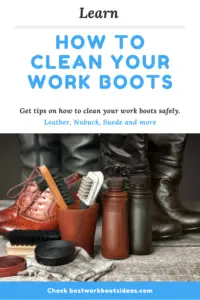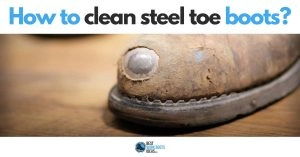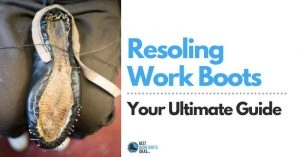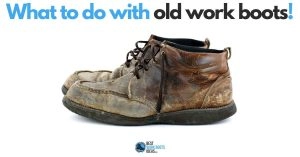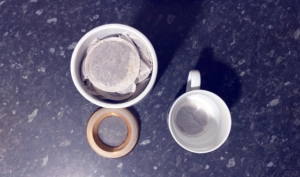How to Waterproof Leather Work Boots: Keep Your Feet Looking Fresh and Dry!
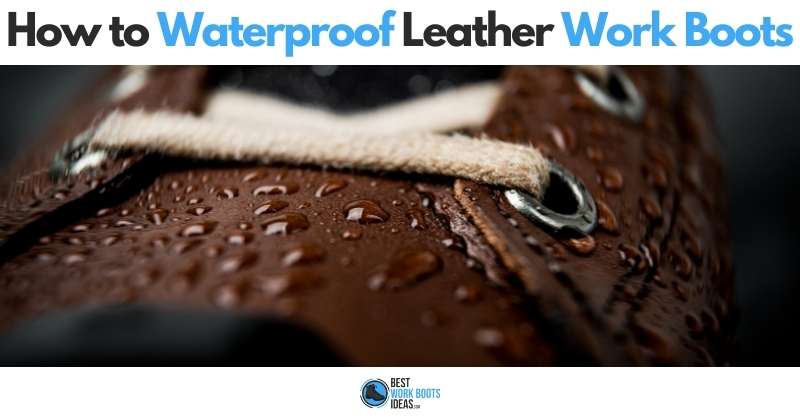
Maintaining your work gear is often overlooked, but it’s absolutely the most important thing you can do to prolong its use.
Today I’m looking at how to maintain your work boots by keeping their leather uppers waterproof.
In this article I’ll go over what you’ll need, what to do with it, and discuss a couple things that come up whenever the discussion turns to leather maintenance.
Contents
How to Waterproof Leather Work Boots – A High Level Waterproofing Method
Step 1 – Ensure you have broken into your work boots.
Step 2 – Clean your work boots.
Step 3 – Dry your work boots
Step 4 – Once dried, apply your chosen waterproofing product
Step 5 – Leave your boots overnight to dry.
No Time For Details, Dr. Jones: How Do I Waterproof My Leather Work Boots?
Set aside a little bit of time, wash your boots, and apply the waterproofing substance of your choice.
There are a number of materials to choose from when waterproofing leather, traditional boot waxes or modern chemical waterproofing sprays, so make sure you’re doing what’s needed for that substance, not one you might have used in the past.
Some require the boots to be entirely dry, others want a slightly damp boot, yet others need the boot to be cleaned, dried, and slightly warmed prior to application of the waterproofing substance.
I’m not going to waste your time by listing the specific requirements of each potential product you choose.
Just remember that you’re going to need to look at the directions of whatever you use, I can’t help you with that one.
If you’re not sure how to wash and dry your boots, check out our articles on those topics to prepare.
If you’ve been considering stretching your boots to deal with a problem area, now’s a good time to do that as well.
No matter the substance you use to waterproof, apply it thoroughly and let it dry!
It does no good to mostly waterproof boots, it has to be done 100% or not done at all.
Get and Stay Stocked: What Supplies Do I Need to Waterproof My Work Boots?
- Workspace
- Soap
- Rags (many)
- Towel – or any type of soft clean cloth.
- Waterproofing Agent (Chemical, Wax, conditioner, spray etc)
There is debate over which waterproofing treatment is best.
Some people prefer products made specifically for the purpose of waterproofing leather.
Although 3M has discontinued Scotchguard (unlike Thinsulate), there are a variety of products you can quickly find on Google or in any boot or leather shop.
Some people, like the gentleman in the video below, make their own waterproofing substance from beeswax and petroleum jelly.
This video was an interesting watch
There are even those out there that say, accurately, that you can waterproof using WD40.
I don’t recommend this method as your boots are going to smell like WD40, and I can’t imagine that it’s healthy to be exposing your body to that unnecessarily.
What Materials Can I Use to Waterproof My Boots?
- Boot Waxes
- Specialized Waterproof Spray for leather boots. Be very careful with Suede and Nubuck leather.
- Boot Oils (Mink Oil)
- Petroleum Jelly
I want to be clear: there is more than one way to skin a cat when it comes to waterproofing your boot.
There is no one way to do this, and it’s just about moisturizing and sealing the material.
As I just said above, you could use WD40, and in terms of keeping water out, it’ll do the job!
That said, I’m a fan of treating quality products kindly, and I err towards boot waxes that aren’t also used to get lawnmowers started.
What to Look For: How Do I Know If My Boots Are Waterproofed
The telltale sign of waterproofing is that water will bead up and run off the boot rather than being absorbed by it.
There should be no darkening of the leather when it makes contact with water as it would normally.
Sometimes you will notice that the water seems to behave differently on different parts of the boot.
If that’s happening, that means your prior waterproofing is fading and it’s time to renew.
Keep in mind, everything has a limit, and if you literally dunk your boots the leather will absorb the water.
There’s no such thing as perfect waterproofing with leather, and if that’s what you’re looking for you should check out a nice pair of pull on boots made of rubber.
Keep a Tight Schedule and an Eye to Details: How Often Should You Waterproof Leather Work Boots?
It’s best to reapply waterproofing treatment to your boots at least once every month. This should be combined with your washing routine to minimize the amount of effort and time your boots are out of commission
Regular Schedule
The best way to maintain your boots is to create a regular schedule in the same way you change oil in your car.
Unlike an engine, this schedule is going to be something you need to decide for yourself.
Masons who spend each day outside in the mud might need to waterproof this twice a month.
Union drywallers might be fine with four times a year, as they’re usually under roof cover and only get their boots wet walking in and out of work.
The level of moisture and mud your boots deal with is the determining factor when deciding on your schedule.
Keep reading to understand the conditions to look for to tell when it’s time for another waterproofing session
Pay Attention to the Condition
Check out how water is behaving when it’s on your boots at work. Is it beading up? Is the leather absorbing water and getting darker? Can you see evidence of the waterproofing still at work?
Water will behave like it’s resting on plastic when the leather is properly waterproofed.
It’ll run off the sides and will maintain its shape while it’s resting there. The color of the leather shouldn’t get darker, as the waterproofing is preventing it from absorbing any moisture.By contrast, if you’re at work and you can see that your boots are darkening and acting like sponges, it’s time to clean, moisturize, and waterproof.
You may not feel the moisture collecting, so don’t rely on your feet, use your eyes instead.
The biggest mistake is to only think about your gear once you’re home and can’t get the information you really want about the situation.
Boots sitting in the mudroom at home usually look fine, but that’s not where their performance matters!
Is All This Really Necessary? Why Do I Need to Waterproof My Work Boots?
You need to waterproof your leather boots to keep your feet dry and to preserve the functionality of the boot. Even if you don’t care about dry feet, everyone wants their boots to continue performing at the highest levels possible and waterproofing them is part of that.
Leather is an amazing natural material that shares many properties with wood in that it can be manipulated into different shapes while retaining its strength. The grains of the leather provide this feature through their ability to respond to heat and moisture.
In a perfect world, our leather uppers would never get wet or muddy, and they’d perform without any required maintenance.
Unfortunately, that’s just not realistic, dirty is part of the job.
Even if your boots are waterproofed by the factory, that’ll diminish after some time, and you’ll need to reapply something.
It’s part and parcel of wear and tear that you’d expect.
I know some people are reading this noting that leather itself is waterproof.
Why waterproof something that’s already waterproof?
Because nothing is completely waterproof, and particularly not a natural, porous material like leather.
It has amazingly water-resistance, but it’s not truly waterproof.
Leather can handle the repeated process of getting wet and then drying for a while.
Eventually though, it does dehydrate the leather.
Dehydrated leather is less pliable, less durable, and less reliable to the person wearing it.
If you continue to abuse your boots without moisturizing them and re-waterproofing them, they will rot, rip, or become worn through.
There’s also the shrinking that is likely to open gaps for water to get in whether you’ve got cement or Goodyear welt construction boots.
In addition to prolonging the life of your boots, it’s sure to make the next wet work day much more bearable.
From the Medicine Cabinet to the Workplace: Can You Use Vaseline to Waterproof Work Boots?
Yes, you can, although it’s not the most effective way.
Most often, you’ll find that people use petroleum jelly as a base in some homemade waterproofing mixture they’re making.
I wouldn’t advise simply slapping some Vaseline on your boots and calling it a day.
If it was that or nothing, it’s better than nothing, but it’s definitely not the most effective method.
Can You Use Olive Oil to Waterproof Work Boots?
Olive oil shouldn’t be used as a means to waterproof your boots.
I’m sure if you look, you’re going to find advocates for olive oil or see it as an ingredient in a waterproofing recipe, but it’s not effective when used on its own.
Additionally, it’s got an odor and texture that you might not want to deal with on your boots.
I advise against anyone thinking their kitchen counter has the solution to their waterproofing situation and use a different material.
Wrapping it Up
No matter which waterproofing substance you choose, your boots and wallet will thank you.
Leather is an amazing material but absolutely needs a helping hand from time to time.
Make sure you don’t forget to give back to the boots that give you so much!

